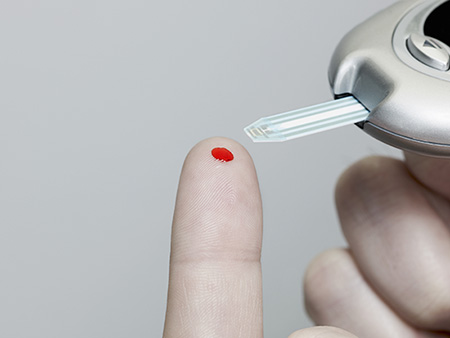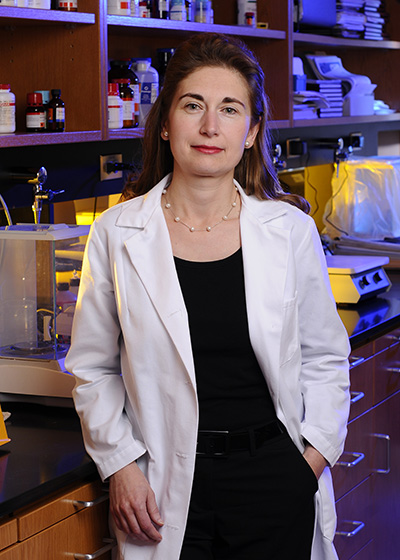
The drug candidate is a non-toxic small molecule that given orally effectively rescued mice from models of Type 1 and Type 2 diabetes.
Tested on isolated human and mouse pancreatic islets, mouse and rat cell cultures and animal models of both Type 1 and Type 2 diabetes, the experimental drug significantly improved four detrimental characteristics of diabetes: hyperglycemia, known as high blood sugar; hyperglucagonemia, elevation in the hormone glucagon that counteracts the effects of insulin, promotes glucose production and increases blood glucose; excessive production of glucose by the liver; and fatty liver, known as hepatic steatosis.
The drug candidate SRI-37330 is a non-toxic small molecule that effectively rescued mice from streptozotocin- and obesity-induced diabetes and improved glucose homeostasis.
A study published in the journal Cell Metabolism describes the strong anti-diabetic properties of this newly designed chemical compound. The researchers, led by Anath Shalev, M.D., director of UAB’s Comprehensive Diabetes Center, said that “compared to currently available diabetes therapies, the compound may provide a distinct, effective and highly beneficial approach to treat diabetes.”
“While the safety and efficacy of SRI-37330 in humans still remains to be determined,” Shalev said, “it is highly effective in human islets, is orally bioavailable and is well tolerated in mice.”
SRI-37330 was discovered through two decades of research by Shalev, followed by high-throughput screening of 300,000 compounds and extensive medicinal chemistry optimization at Southern Research, headquartered in Birmingham.
Diabetes is a disease affecting two hormones — insulin and glucagon. In healthy individuals, insulin helps cells take up glucose from the blood when glucose levels are high, and glucagon helps the liver release glucose into the bloodstream when glucose levels are low. In diabetes, insulin release is diminished, cell sensitivity to insulin can decrease, and glucagon release is excessive. This can cause a vicious cycle of escalating blood glucose levels.
SRI-37330 appears to act beneficially on pancreatic islets that produce the two hormones, and also at the liver.
Diabetes affects 425 million people worldwide and more than 30 million in the United States. It is a growing epidemic, with 1.5 million Americans newly diagnosed each year. The preclinical studies led by Shalev suggest that the potential drug SRI-37330 could be beneficial in both Type 1 and Type 2 diabetes, including both lean and obese individuals. Also, diabetes appears to be a significant co-morbidity in the current COVID-19 pandemic.
 The 80 million people in the United States who have prediabetes might also benefit from the potential drug. Furthermore, the effectiveness of SRI-37330 in reducing fatty liver in mice suggested it might have potential to treat non-alcoholic fatty liver disease, which affects about 100 million people in the United States and 1 billion worldwide.
The 80 million people in the United States who have prediabetes might also benefit from the potential drug. Furthermore, the effectiveness of SRI-37330 in reducing fatty liver in mice suggested it might have potential to treat non-alcoholic fatty liver disease, which affects about 100 million people in the United States and 1 billion worldwide.The path to discovery of SRI-37330 began 18 years ago when Shalev and colleagues identified the protein TXNIP — pronounced “tix-nip” — as the top glucose-induced gene in human islets, which are the cell groups in the pancreas that produce insulin and glucagon. This was followed by their work showing that TXNIP negatively affected islet function and survival, suggesting that TXNIP might play an important detrimental role in diabetes.
In previous research, Shalev and colleagues also showed that TXNIP was increased in different mouse models of diabetes and in diabetic human islets, and that deletion of the TXNIP gene protected mice from diabetes and had beneficial effects on pancreatic islet biology. Altogether, these data suggested that a search for a TXNIP inhibitor could provide a novel approach to diabetes treatment.
Study details
Some of the details of the current study — which covers 10 years of work — involve the inhibitory effect of SRI-37330 on the TXNIP gene. SRI-37330 inhibited activity of the TXNIP promoter by 70 percent, and it showed a dose-dependent inhibition of TXNIP mRNA and protein.RNA sequencing of isolated human pancreatic islets treated with SRI-37330 showed that TXNIP signaling was inhibited as demonstrated by a number of upregulated and downregulated genes. It further showed that SRI-37330 specifically inhibited TXNIP, but not other members of the arrestin family or general transcription.
Importantly, the Shalev lab previously showed that non-specific inhibition of TXNIP signaling by the calcium channel blocker verapamil has beneficial effects in human subjects with recent onset Type 1 diabetes, suggesting that this approach might be translatable.
Of note, SRI-37330 is effective in reducing TXNIP in the nanomolar range, has an oral bioavailability of 95 percent, shows no cytotoxicity in vitro and no toxicity in mice, even at doses about 10-fold above its therapeutic dose, and has already tested negative in Ames mutagenicity assays, CYP450 inhibition, hERG inhibition and Eurofins SafetyScreen for off-target liabilities, including no inhibition of calcium channels.
Strikingly, addition of SRI-37330 to the drinking water of obese diabetic db/db mice, a model of severe Type 2 diabetes, led within days to normalization of their blood glucose. Similarly, SRI-37330 also protected mice from streptozotocin-induced diabetes, a model of Type 1 diabetes. Of note, SRI-37330 achieved even better blood glucose control than two of the leading oral anti-diabetic drugs, metformin and empagliflozin.
“Together with the fact that SRI-37330 was also effective after the onset of overt diabetes, as well as when just dosed twice a day by oral gavage, is particularly promising and raises the possibility that SRI-37330 may ultimately lead to a much-needed oral drug that could also be used for Type 1 diabetes,” Shalev said.
Surprisingly, SRI-37330 decreased blood glucose levels primarily via lowering of serum glucagon levels and inhibition of basal glucose production from the liver. This mode of action is very different from that of currently used anti-diabetic drugs.
Despite SRI-37330’s reduction of glucagon release from pancreatic islets and reduction of glucose production by the liver, the inhibitor did not cause any low blood glucose events or create a hypoglycemic liability in mice, even in the context of insulin-induced hypoglycemia.
In another surprising result — and in contrast to previous attempts to inhibit glucagon function for the treatment of diabetes — the inhibitor dramatically improved the severe fatty liver observed in obese diabetic db/db mice. “This now raises the intriguing possibility,” Shalev said, “that SRI-37330 might also be beneficial in the context of non-alcoholic fatty liver disease, a complication frequently associated with diabetes and/or obesity.
“In summary,” Shalev said, “our studies have identified a novel substituted quinazoline sulfonamide, SRI-37330, that is orally bioavailable, has a favorable safety profile and inhibits TXNIP expression and signaling in mouse and human islets, inhibits glucagon secretion and function, lowers hepatic glucose production and hepatic steatosis, and exhibits strong anti-diabetic effects in mouse models of Type 1 and Type 2 diabetes.”
Co-authors with Shalev on the study, “Identification of an anti-diabetic, orally available, small molecule that regulates TXNIP expression and glucagon action,” are Lance A. Thielen, Junqin Chen, Gu Jing, Guanlan Xu, SeongHo Jo, Truman B. Grayson and Brian Lu, UAB Comprehensive Diabetes Center and Department of Medicine, Division of Endocrinology, Diabetes and Metabolism; Omar Moukha-Chafiq, Corinne E. Augelli-Szafran and Mark J. Suto, Drug Discovery Division, Southern Research; Peng Li, UAB School of Nursing; Matt Kanke and Praveen Sethupathy, College of Veterinary Medicine, Cornell University, Ithaca, New York; and Jason K. Kim, University of Massachusetts Medical School, Worcester, Massachusetts.
Support came from National Institutes of Medicine grants DK120379 and DK078752, and from the Alabama Drug Discovery Alliance.
At UAB, Shalev is the director of the Comprehensive Diabetes Center and a professor in the Department of Medicine Division of Endocrinology, Diabetes and Metabolism, and she holds the Nancy R. and Eugene C. Gwaltney Family Endowed Chair in Juvenile Diabetes Research.
by Jeff Hansen
uab.edu


